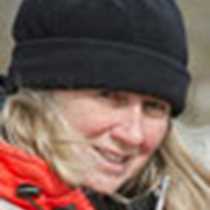Akureyri and Siglufjordur, Iceland
Land and sea were one, wrapped in a blanket of fog for most of the day. One could imagine we were on separate universes as we ventured in diverse directions. Five gaited Icelandic horses carried some away through verdant green pastures on the edges of Eyjafjordur. Others explored Akureyri, a tiny town in appearance and population (16,000), and yet the second largest city in Iceland. The moisture in the air turned to diamonds as it condensed on the colorful display of vegetation in the botanical garden perched above the town. We wondered where else in the world a giant dandelion would be awarded a place of prominence and a label all its own. As it is often said, a weed is only something growing where it is not wanted. So why should a native species with a fine yellow crown not be grown with other native vegetation?
We sailed in the thick fog, never lost, for the magic of electronics drew us shorelines and ships and a tiny vessel plotted our course on the chart. Here and there a glacial horn would peak through a void in the white. Sounds of fulmars patterning across the water seemed to be magnified. Our mind drew lines to connect the cliffs to the shore. We were surely in a fjord for the signs of glaciation were all there; a cirque here, a hanging waterfall there, a side valley scooped into a U. Then there was a pier, another tiny town. And what a stir we made as we sidled carefully in to the dock. Curious town folk dashed to the quay or peered from balconies. Only the children playing at school seemed too preoccupied to wonder why we were there.
A hundred years ago this town, Siglufjordur was the "Klondike of the Atlantic." Fishing vessels raced toward the herring rich waters. Processing plants grew. The sound of machinery clattering might only have been matched by the din of the "herring girls" arguing or flirting with the boys. These women were skilled at what they did, standing all day long decapitating and gutting herring with a single swipe of the knife. Layered with salt and spices and packed in barrels, the fish awaited their fate. Oil became cosmetics or varnish, soap or margarine. The solids became meal, protein-rich fodder. As with every gold rush, the boom was to become a bust. The fish disappeared. The history lives on now in the Herring Era Museum where we partied with the "herring girls" until it was time to go once again, out into the fog.
It never ends this magic. Night and bed are in our thoughts, but clear, still air and glassy seas reveal two dozen or more glowing spouts from humpback whales. Close to the sea, in Zodiacs, we become part of their world, moving here and there as pewter light becomes pastel pink and blue.
Land and sea were one, wrapped in a blanket of fog for most of the day. One could imagine we were on separate universes as we ventured in diverse directions. Five gaited Icelandic horses carried some away through verdant green pastures on the edges of Eyjafjordur. Others explored Akureyri, a tiny town in appearance and population (16,000), and yet the second largest city in Iceland. The moisture in the air turned to diamonds as it condensed on the colorful display of vegetation in the botanical garden perched above the town. We wondered where else in the world a giant dandelion would be awarded a place of prominence and a label all its own. As it is often said, a weed is only something growing where it is not wanted. So why should a native species with a fine yellow crown not be grown with other native vegetation?
We sailed in the thick fog, never lost, for the magic of electronics drew us shorelines and ships and a tiny vessel plotted our course on the chart. Here and there a glacial horn would peak through a void in the white. Sounds of fulmars patterning across the water seemed to be magnified. Our mind drew lines to connect the cliffs to the shore. We were surely in a fjord for the signs of glaciation were all there; a cirque here, a hanging waterfall there, a side valley scooped into a U. Then there was a pier, another tiny town. And what a stir we made as we sidled carefully in to the dock. Curious town folk dashed to the quay or peered from balconies. Only the children playing at school seemed too preoccupied to wonder why we were there.
A hundred years ago this town, Siglufjordur was the "Klondike of the Atlantic." Fishing vessels raced toward the herring rich waters. Processing plants grew. The sound of machinery clattering might only have been matched by the din of the "herring girls" arguing or flirting with the boys. These women were skilled at what they did, standing all day long decapitating and gutting herring with a single swipe of the knife. Layered with salt and spices and packed in barrels, the fish awaited their fate. Oil became cosmetics or varnish, soap or margarine. The solids became meal, protein-rich fodder. As with every gold rush, the boom was to become a bust. The fish disappeared. The history lives on now in the Herring Era Museum where we partied with the "herring girls" until it was time to go once again, out into the fog.
It never ends this magic. Night and bed are in our thoughts, but clear, still air and glassy seas reveal two dozen or more glowing spouts from humpback whales. Close to the sea, in Zodiacs, we become part of their world, moving here and there as pewter light becomes pastel pink and blue.




